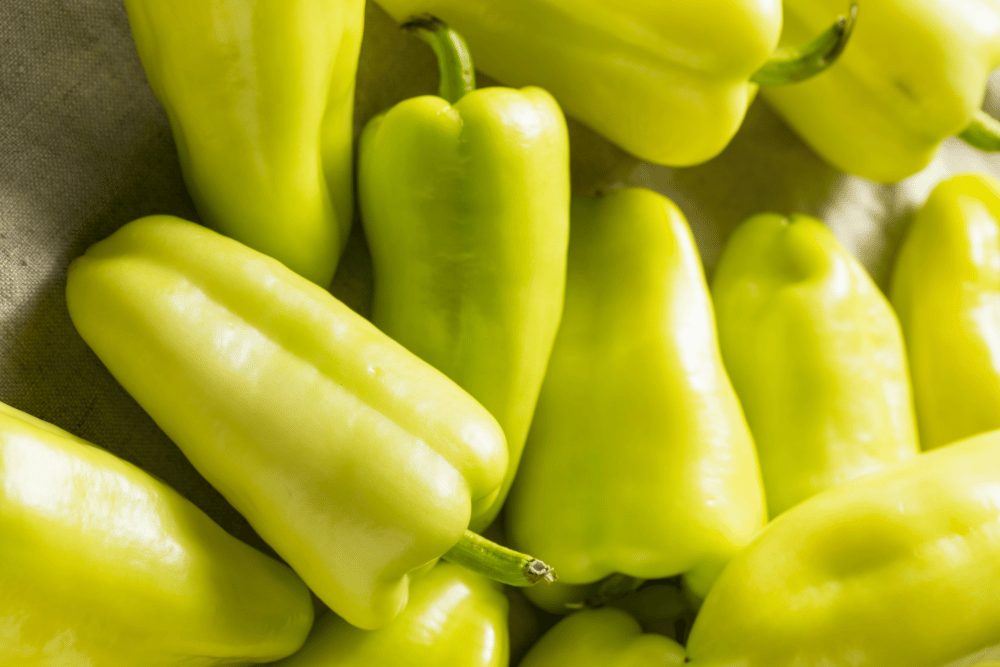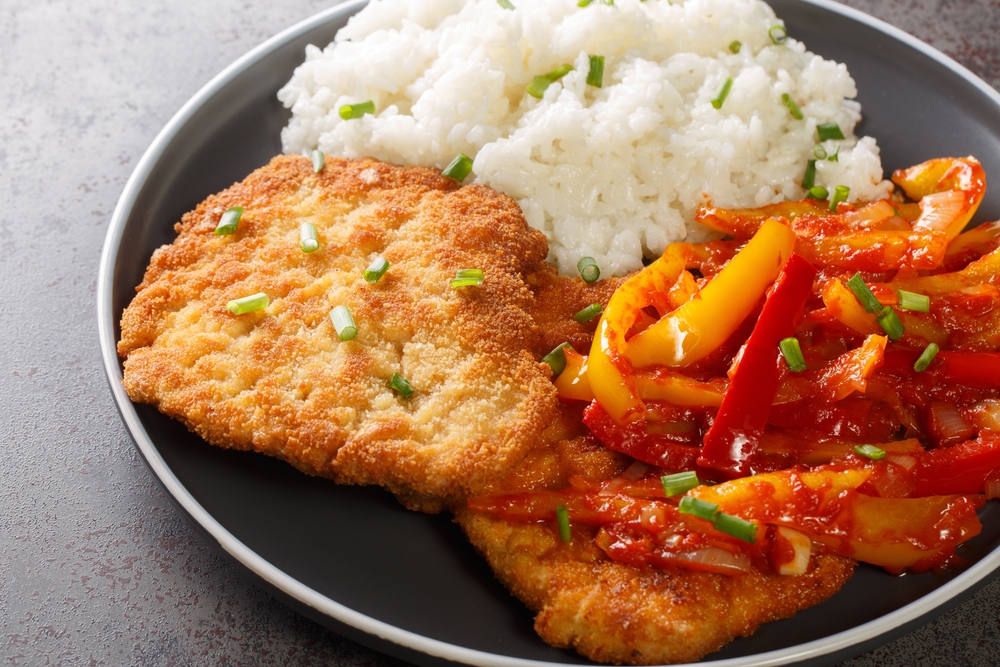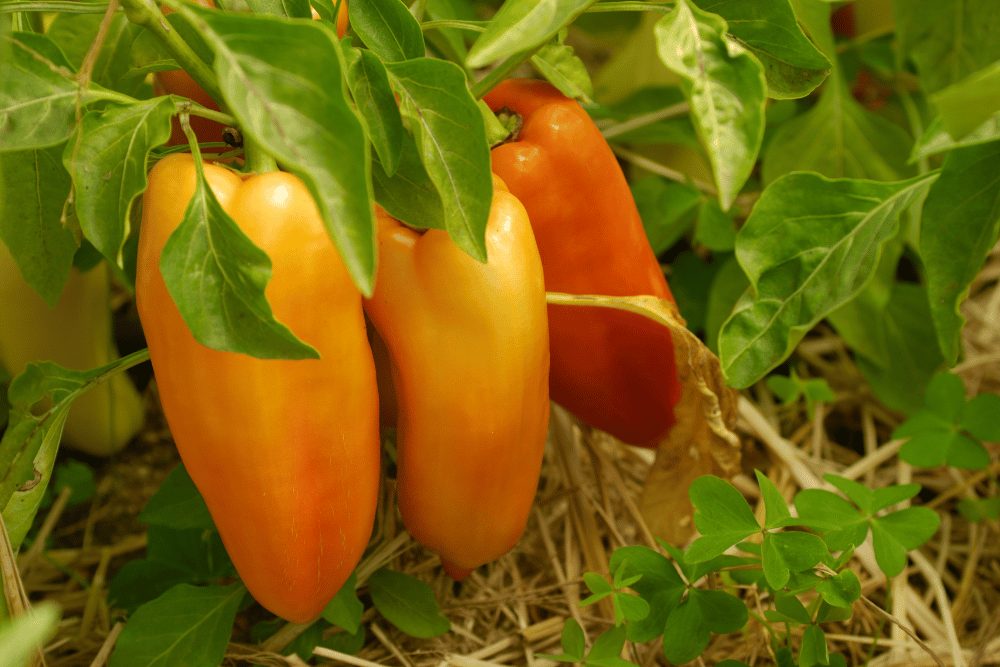Gypsy peppers are a US-developed hybrid of bell peppers and Italian bullhorn peppers. They are famed for their sweetness, productivity, disease resistance, and simultaneous colors at different ripening stages on the same plant.
What Is A Gypsy Pepper?
Gypsy peppers are a hand-bred hybrid between bell peppers and Italian bullhorn peppers developed by Petoseed, a Southern California seed company famed for hybridizing tomatoes and peppers.
Petoseed developed the gypsy pepper variety in 1980 as a pepper plant resistant to the tobamovirus (tobacco mosaic virus). The pepper gained recognition in 1981 for its tremendous garden value and has since become a favorite pepper for many growers and cooks in the US and Mexico.
Gypsy peppers belong to the Capsicum annuum species and are identifiable by their unique color profile, large size, exceptional flavor, smooth texture, and shape reminiscent of bell peppers and jalapenos.

Color
Gypsy peppers are no different from other peppers in their color profile—they start a pale yellowish-green and develop different colors at various stages of maturity.
Gypsy peppers start pale green before turning yellow, orange, and red when fully ripe.
The colors usually merge in between the transitions, so you will enjoy different colors simultaneously on the same plant at varying stages of maturity and ripening.
The multi-color phenomenon turns your garden into a beautiful natural art piece!
Shape And Size
Gypsy peppers are large, heavy fruits measuring 4-6 inches (10-15 centimeters) long and about two inches (5 centimeters) wide. The peppers have lobes, broad shoulders like bell peppers, and a sharp tapering profile like jalapeno peppers.
Texture
Gypsy peppers have smooth, glossy, and thin skin. The firmness of the flesh gives the peppers their characteristic crunch. You’ll love them for their crispness when eaten raw on a crudite board or in salads and salsas.
Are Gypsy Peppers Hot Or Sweet?
Being a hybrid derived from bell peppers, gypsy peppers have zero heat or spiciness. Like bell peppers, their Scoville rating is 0 SHUs.
Gypsy peppers are famed for their sweet flavor. Green gypsy peppers taste sweet but slightly acidic, like green bell peppers.
When a gypsy hybrid pepper ripens fully, it has the sweetest flavor, almost floral if it grows under optimal conditions.
What’s The Difference Between A Bell Pepper And Gypsy Pepper?
Gypsy peppers are a hybrid of bell peppers, meaning they show remarkable improvement over bell peppers. Like Carmen peppers, another hybrid, gypsy peppers are sweeter and more prolific.
Bell peppers originate from Mexico, South America, and Central America. Gypsy peppers, on the other hand, are native to the US, having been developed in the country through hybridization.
While the typical bell pepper plant bears 5-10 peppers, gypsy peppers plants are far more prolific and bear 50-100 pepper pods per season. You might have to support your gypsies when they are heavy with fruit!
What Are Gypsy Peppers Used For?
You can use gypsy peppers in the same way as bell peppers, especially when you want something sweeter and more nuanced. They are excellent for general cooking as a flavor base to add sweetness to various dishes.
Gypsy peppers are eaten raw in sandwiches, salads, dips, or vegetable trays. You can slice them into strips and serve them raw with dips for a crunchy snack.
Gypsy peppers also make for excellent stuffing and frying peppers because of their large cavities and thin walls. You can stuff them with cheeses and meats before frying or baking them. You could also dice and mix them in stir-fries.
The peppers are suitable for roasting, grilling, pickling, drying, canning, and sauteing. Try substituting them in the famous German dish, zigeunerschnitzel—fried pork schnitzel with a sauce of sauteed bell peppers and tomatoes.
You might also want to charr gypsy peppers to add a smoky flavor to their sweet profile before serving them with food items like Mexican hoagies.

Gypsy Red Pepper Jelly
Fully ripe red gypsy peppers are delicious in sweet, zero-heat red pepper jelly. Here’s a recipe you might want to try at home! You can add mildly hot peppers like Anaheim peppers for some heat in the jelly.
Print
Gypsy Pepper Jelly
- Yield: 7 cups 1x
Description
Sweet red pepper jelly is delicious with cream cheese on a crostini.
Ingredients
3 cups finely chopped red gypsy peppers
3 cups distilled white vinegar
13 cups white sugar
6 ounces of liquid pectin
Instructions
- Combine red gypsy peppers, white vinegar, and sugar in a stainless steel saucepan. Boil the mixture and cook for 6 minutes while stirring thoroughly.
- Add liquid pectin, stir thoroughly, and boil the mixture for three more minutes while stirring constantly. Use a metal spoon to remove the foam. Remove the saucepan from the heat.
- Scoop the jelly into sterilized jars without filling them up (leave about 1/2-inch space at the top). Seal the jars and process the jelly in a boiling-water canner for about 5 minutes.
- Category: Condiment
How Do You Know When Gypsy Peppers Are Ripe?
You’ll know your gypsy peppers are ripe when they turn red. The color cycle goes from green to yellow to orange to red, meaning you can harvest and enjoy the peppers at any maturity stage.
Where To Buy Gypsy Peppers
Gypsy peppers are available in farmers’ markets, local groceries, and specialty stores or groceries across the US and Mexico. Farmers’ markets usually carry the freshest produce grown organically on local farms.
Can You Grow Gypsy Peppers?
Like bell peppers, gypsy peppers are easy to grow. The peppers have been an heirloom since the 1980s, and their seeds are now widely available online or at local gardening centers.
To grow gypsy peppers like a pro, you’ll have to sprout the pepper seeds indoors about eight weeks before the last frost. Transplant or set the young plants outdoors about 1-2 weeks after the last frost.
Gypsy peppers do well in both warm and cooler climates but need full sun exposure for at least six hours daily. A little shade is necessary for very hot areas.
For the best results, plant your gypsy pepper plants in neutral or non-acidic soil with a PH of at least 6. The soil should be well-drained, fertile, and moist.
Plant the seedlings singly in containers or directly in the garden with a spacing of 18-24 inches between them.
Substitutes For Gypsy Peppers
You can substitute gypsy peppers with bell peppers, Santa Fe Grande peppers, pimentos, albino sweet peppers, and Carmen peppers (a type of bull’s horn sweet peppers).

